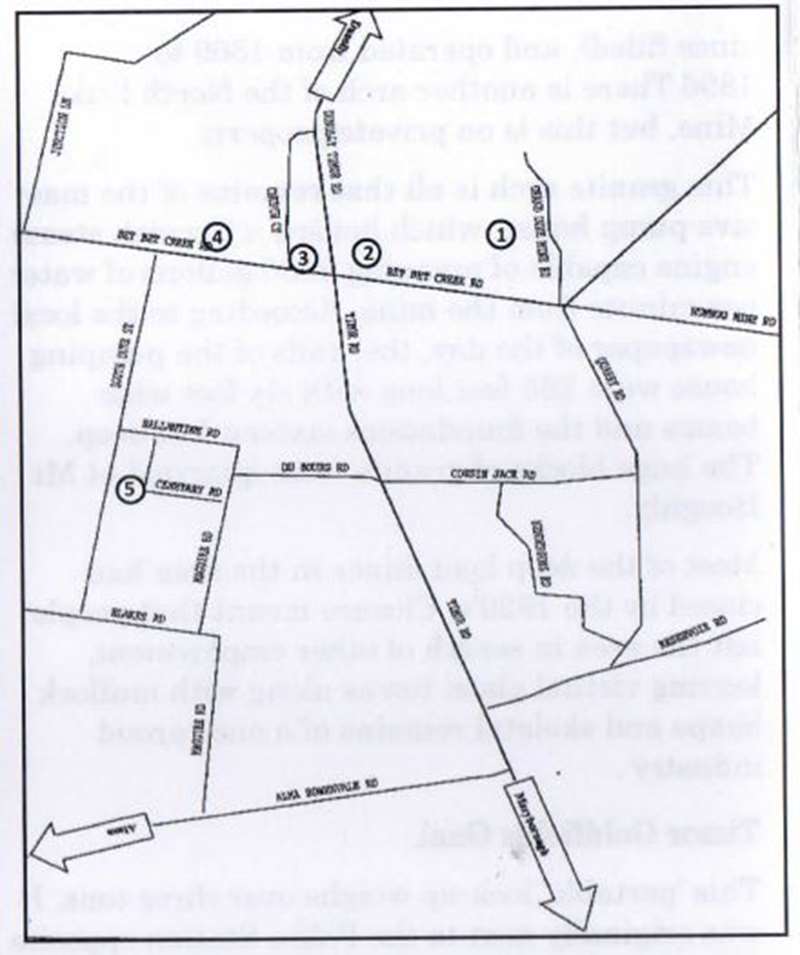Timor Historic Tour

Gold was first discovered in this region at Chinaman's Flat in 1854. Only 500 miners were at the first rush, one month later it was in excess of 16,000. Originally known as Coxtown after the local Butcher, it was surveyed as Timor in 1856. Once a thriving gold town with a population in excess of 27000, Timor had 38 hotels, three butchers, two banks, three bakeries, a police station and several lock ups. The last hotel closed its doors during the 1960s. Today, the only historic buildings remaining in this quiet little town are the school (1873), Post Office (1865), one of the lock-ups and the general store (1852). The granite arch of the Grand Duke Mine may also be visited. Timor is renowned for its alluvial gold and quartz mining as well as its fertile farmland along the Bet Bet creek.
Besides the corner store, there is not much left of the once dynamic Bowenvale-Timor mining district. One of Victoria's most lucrative alluvial gold leads ran through Bowenvale-Timor.
Between 1870 and 1900 this became the cornerstone for a rich industry of deep-lead mines. Companies sank shafts here to tap buried gold and miners worked around the clock in shifts. These miners founded their own Bowenvale Miners Accident Fund - a small step towards security for workers in a lethal industry.
Once companies like the Duke and Timor or the Alma Timor United had closed down, cyaniding was used to extract the last riches from the heaps of mine waste. Remnants of this vast mining enterprise can still be seen in the Grand Duke mine site, the Bismarck United and Alma-Timor United mine.
Fires had run through wooden shops and a miners' boarding house in 1896 destroying several other buildings as well.
In 1904 a disaster at the Duke United Mine killed two miners. By the time of the 1914-18 war, gold yields had declined and many young men volunteered for the AIF. Percy Simmons was one Bowenvale miner who sailed for France to reinforce the 6th Battalion, in 1916. Percy was killed in action in August 1918, only a few months before war ended and at the age of 26.
At the corner of Cousin Jack and Timor Roads stands the simple obelisk of the Timor-Bowenvale War Memorial. Designed locally, it was unveiled by Percy's mother on 26 April 1926. The memorial column has neither inscription nor names. Instead Percy, like so many other young Australians, is memorialised at the Australian National War Memorial, Villiers-Bretonneux, France.

Points of Interest Map

1. Grand Duke Arch

The granite arch of the Grand Duke Mine is one of the few reminders of the age of gold mining in this area. Once employing 150 men the mine yielded 6125 kilograms of gold and was one of the longest serving wet mines in Victoria. It had four shafts (long since filled), and operated from 1869 to 1896. There is another arch of the North Duke Mine, but this is on private property.
This granite arch is all that remains of the massive pump house, which housed a Cornish steam engine capable of pumping 2000 gallons of water per minute from the mine. According to the local newspaper of the day, the walls of the pumping house were 265 feet long with six foot wide beams and the foundations sixteen feet deep. The huge blocks of granite were quarried at Mt Hooghly. Most of the deep lead mines in the area had closed by the 1920's. Closure meant that people left the area in search of other employment, leaving virtual ghost towns along with mullock heaps and skeletal remains of a once proud industry.
2. Timor Primary School

Primary School 1207 The school was established in 1873, with the present building being completed and opened in 1880. Records show in 1883 there were 640 children with 10 teachers. A wooden classroom was added at the rear of the building as pupil numbers exceeded 400, however this was removed in 1937 as numbers dwindled. Now over 125 years old, the school still remains a focal point of the town.
3. Timor General Store & Gaol


This 'portable' lock-up weighs over three tons. It was originally next to the Police Station opposite the general store, and was used to temporarily house villains until they could be moved to a larger penitentiary. When the station closed in 1915 it was moved to its present position and for a while it was used by the local undertaker to store coffins. This particular building was built in the early 1900's.
4. Eucalyptus Distillery
Eucalyptus oil was one of the first natural products exported from Australia, with a sample being sent to Sir Joseph Banks in 1788. Commercial production in Victoria did not begin until around 1854.
The distillery in Timor operated from the early 1960's until 1980's. It was a one man operation with leaves being stripped from the branches and packed into vats which were then sealed with clay. Steam from the boiler was then passed through the leaves into pipes which were cooled in a pool of water. The condensed steam & oils were collected in a bucket, the oil would float to the surface and was then skimmed off and sent for refining. Eucalyptus oil is very much in use today, and used in cosmetics, medicines and fragrances.
5. Cemetery

Timor Cemetery The earliest burial took place in 1870. Many tombstones tell of tragic deaths of men in the mines; sadly many early records of graves were lost in a fire at the general store in 1889. There is a cemetery trust for those wishing to trace ancestors.
Photos:
Location
Grand Duke Mine Road, Timor 3465 View Map








